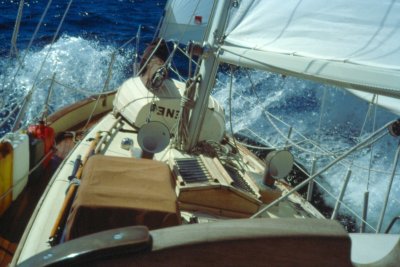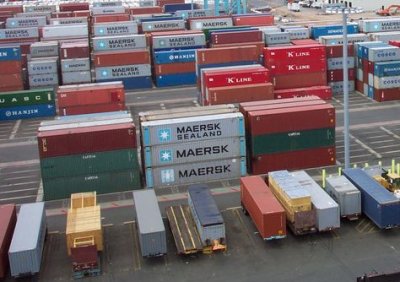

 Share This Page
Share This Page| Home | | Sailing | | Alaska 2007 | |  |  |  Share This Page Share This Page |

Copyright © 2007, P. Lutus. All rights reserved. Message Page
(double-click any word to see its definition)


It is not a question of whether you will hit something with your boat. It is a question of when, and how hard. I've been sailing for twenty years now, and I've hit a lot of things in a lot of places — coral reefs, logs, even whales.
When I shopped for my first boat, twenty years ago in 1987, I had no boat experience at all, so I bought a very strong, conservatively designed boat. It wasn't very big — I didn't want a boat too big for one person to control — and very strongly built (a Crealock-designed Pacific Seacraft "Mariah", 31 feet). I had been reading books by sailors with long experience and perhaps took their advice to an extreme.
I sailed that boat solo around the world between 1988 and 1991, a story told in my online free book "Confessions of a Long-Distance Sailor." But, contrary to what I hoped, I hit things in the water with discouraging regularity, and my having bought a strong boat turned out to be more than simple prudence.
One night in the Indian Ocean, I hit a waterlogged shipping container that was too low in the water to show up on radar, but it was a massive metal object, much bigger than my boat. A loud bang and a serious lurch woke me from a deep sleep, as the boat's speed was abruptly reduced by several knots. Loose items flew through the cabin, including me. I realized I might have a hole through my hull, so I took the boat apart, dumping things out of storage areas that adjoined the hull. But ... no hole, no water coming in. I was lucky.
Months later, in Tel Aviv, Israel, I had the boat hauled out of the water for routine maintenance and painting, and I saw where the container hit. There was a huge scar with three lines radiating from its center — it turns out one corner of the the container tried to push through my boat's hull, but didn't quite manage it. This is because the hull was three inches (about 7.5 centimeters) thick below the water line. This sort of design is rather extreme, it made the boat too heavy to sail very efficiently, but on the other hand I and my boat are not at the bottom of the Indian Ocean today.
A digression. There are a huge number of shipping containers floating around on the open ocean, many more than, say, thirty years ago. One reason is simple — more international commerce. Another reason is more subtle. A typical container is a big metal box, identical in size and shape to a trailer being trucked along a highway (and chances are that trailer is a shipping container). Inside the container, you might find a bunch of DVD players or TV sets, each enclosed in carefully shaped pieces of Styrofoam. It turns out if a container falls off a freighter during a storm, the water enters the container right away, but it can't penetrate the Styrofoam. Consequently the container might float around for months or years, waiting to hit a passing boat, until the metal box finally rusts through and releases its contents.
But the Indian Ocean collision was unavoidable — the only way to avoid it would have been to stay home. By contrast, this season's collision was stupid and easily avoided. I was trying to enter Kaflia Bay, west of Kodiak Island on the Alaska Peninsula, a decent bear area, and coincidentally close to the place where Timothy Treadwell and Annie Huguenard were eaten by bears in 2003. The entrance is very shallow and the current can be strong.
When considering an entrance like this, it's a textbook principle to wait for high slack water before entering, to minimize the risk. I've analyzed the relationship between water heights and currents in this kind of entrance (read this article for more detail), and there is a danger in waiting for high slack water, in particular while entering a bay. The danger is that there may still be plenty of current drawing a vessel into the bay at the time of high slack, and if one should get pinned to a rock at that moment, the tide can only fall and make the situation worse. If one enters on a rising tide, the current will probably be worse, but at least one might be lifted from a rock by the rising water.
The conclusion is that there is no good time to enter a bay with a shallow entrance. If you enter before high tide, you may be lifted off a rock later, but the entrance is shallower then and the current is stronger, also the current's direction pulls you into the bay (it's much better to maneuver a boat against an opposing current, you have more control). If you enter after high tide, the current will be flowing out of the bay, an advantage, but the water will be dropping, so if you hit a rock, the tide will fall and may trap you there. Worse, the moving, falling water may roll your boat over and sink it.
Many sailors don't realize this, but the oft-head expression "high slack water" is nearly always a myth. In confined, shallow bay entrances, the water is sometimes high, and sometimes slack, but not at the same time, for reasons explained here.
Also, when I visit bear areas, I like to arrive when there will be particularly low tides, because the bears come into the open to hunt for clams, and I can take pictures. But low tides means tidal extremes, and tidal extremes mean strong currents in bay entrances.
I had successfully entered Kaflia bay a number of times in the past, so perhaps I was being overconfident, and I wasn't willing to wait for high tide. I moved slowly across the entrance, running the engine just fast enough to make the boat maneuverable (did you know you can't steer a boat that isn't moving? Just like a life). But the inrushing current drew me against a rock — bang! I reversed the engine and backed out, then considered whether I had a hole through the hull below the water line. After some exploring, I decided I wasn't taking on water, so I moved on to a bay with an easier entrance.
I've since taken the boat out of the water, and (just as in Tel Aviv years ago) I saw where the rock banged the hull and mangled a small area of fiberglass right by the bow. After repairs, again consistent with my prior experience, the bow is restored to its original state.
This reminds me of a similar situation last year, when I got stuck on a shallow spot while entering Halibut Cove Lagoon near Homer on a rising tide — I wanted to hike a trail that began inside the lagoon, and I entered on a rising tide, as usual. That day the inrushing current was much stronger than I expected — about four knots — and it pushed me onto a gravel bar. I was stuck there for quite a spell, until I realized to avoid being permanently trapped I would have to back the boat off by using the engine to counter the current (meaning a relatively high power setting). This got me free, but the churning gravel banged up the propeller.
I have to tell you it's a strange experience to be in a boat, sitting motionless in shallow water, showing a speed of four knots. It's a bit scary, too.
I once visited another Nordic Tug 37 and, while exploring the engine room, I found one of those tool organizer boards, with tools hanging from pegs, very orderly, just like in someone's garage. I said to the boat's skipper, "What happens in rough seas? Don't the tools go flying around the engine room?" He paused for a moment, then said, "My wife doesn't let me go places where the water is rough."
Hmm.
| Home | | Sailing | | Alaska 2007 | |  |  |  Share This Page Share This Page |